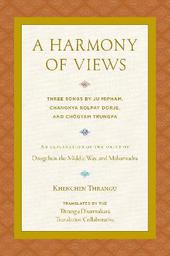
|
A Harmony of Views: Three Songs by Ju Mipham, Changkya Rolpay Dorje, and Choegyam Trungpa
Paperback / softback
Main Details
| Title |
A Harmony of Views: Three Songs by Ju Mipham, Changkya Rolpay Dorje, and Choegyam Trungpa
|
| Authors and Contributors |
By (author) Khenchen Thrangu
|
|
By (author) Thrangu Dharmakara Translation Collaborative
|
| Physical Properties |
| Format:Paperback / softback | | Pages:224 | | Dimensions(mm): Height 229,Width 152 |
|
| Category/Genre | Religion and beliefs |
|---|
| ISBN/Barcode |
9781559394963
|
| Classifications | Dewey:294.3420423 |
|---|
| Audience | |
|---|
|
Publishing Details |
| Publisher |
Shambhala Publications Inc
|
| Imprint |
Snow Lion Publications
|
| Publication Date |
4 August 2020 |
| Publication Country |
United States
|
Description
Three songs by recognized masters of different Tibetan Buddhist traditions illustrate what their views have in common--with commentary by Thrangu Rinpoche and songs by Ju Mipham, Changkya Rolpay Dorje, and Ch gyam Trungpa. Do different Tibetan Buddhist traditions share an essential, common view? The great Geluk scholar Changkya Rolpay Dorje (1717-1786) wrote a song describing the view of the Middle Way, comparing it to a mother. Later, the nonsectarian polymath Ju Mipham Rinpoche (1846-1912) and the influential Kagyu master Ch gyam Trungpa Rinpoche (1939-1987) wrote songs modeled upon it that describe the views of dzogchen and mahamudra, one comparing dzogchen to a jewel and the other comparing mahamudra to a lover. Even though the imagery and the specific points each author makes are different, the songs share many characteristics in structure and content. Read together, the three songs show how the essential points of these three practices are the same and reveal how Buddhism's various traditions--including the pinnacles of the Middle Way, dzogchen, and mahamudra--are harmonious. The three songs are presented with a commentary by Khenchen Thrangu Rinpoche, who explains how studying the profound view helps develop the certainty that is necessary to bring meditation practice to fruition. He shows how songs such as these can serve as antidotes to discouragement and provide help to people who have had strong meditation experiences but find themselves unable to sustain a high level of practice. Thrangu Rinpoche explains that, in comparison to oral instructions and treatises, songs of this kind are of special benefit because of their engaging eloquence. The songs are not long, and they are a delight to read, reread, and memorize. By clarifying the view again and again in this way, they offer continual inspiration to practitioners.
Author Biography
KHENCHEN THRANGU was born in Tibet in 1933. At the age of five, he was formally recognized by His Holiness the Sixteenth Karmapa and Tai Situpa as the ninth incarnation of the great Thrangu tulku. At twenty-seven, Thrangu Rinpoche was forced to flee to India. He was called to Rumtek monastery in Sikkim, where he was given the task of preserving the teachings of the Kagyu lineage. He was appointed by H.H. the Dalai Lama to be the personal tutor for the Seventeenth Karmapa and the four principal Karma Kagyu tulkus. Thrangu Rinpoche established the fundamental curriculum of the Karma Kagyu lineage taught at Rumtek and founded numerous monasteries and nunneries, schools for Tibetan children, and medical clinics. He has taught extensively throughout the world and is the abbot of Gampo Abbey.
Reviews"The three songs here by greatly realized masters from three distinct Tibetan Buddhist traditions show that the famous 'three Great Ones'-Great Madhyamaka, the Great Seal, and the Great Perfection-all come down to the same essential point: the unmistaken realization of mind's true nature, just as it is. In their clarity and poetic beauty, these songs resemble brilliant ornaments crafted from the pure gold of our innate nature, while the Venerable Thrangu Rinpoche's lucid comments are like displaying these ornaments in the most conducive vitrines so that they can be viewed and appreciated from all kinds of different angles. These teachings are indispensable for all Buddhist practitioners in order to gain perfect clarity about the profound view of ultimate reality and how it informs our practice."-Karl Brunnhoelzl, translator of A Compendium of the Mahayana
|